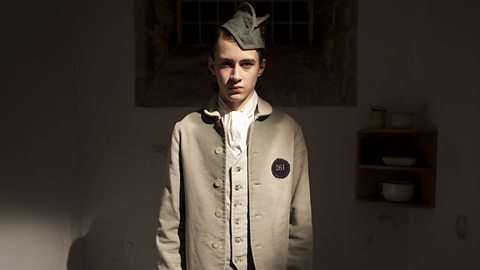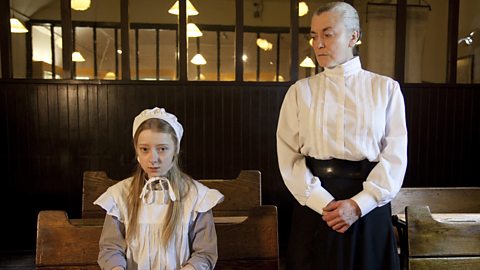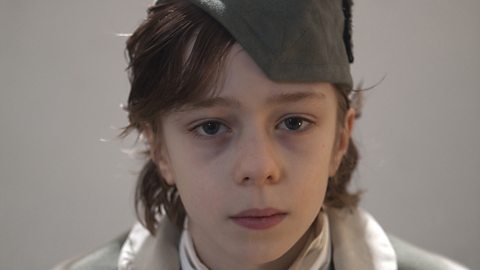Video summary
The story of young offender James Dunn Barr is used to explain how the invention of photography changed the way criminals could be identified.
Until the mid-19th Century, the only records of child offenders were written accounts of their trials. Then the invention of photography changed everything.
By the 1870s every criminal, young and old, had their photograph taken for police records.
Many of these still exist, as this short film shows, giving us a remarkable insight into the harsh reality of being a young Victorian in Scotland.
Note that this film includes a reference to the execution of children convicted of crimes, which may be upsetting for some KS2 and KS3 pupils. Teacher viewing is recommended prior to showing the film in class.
Teacher Notes
Questions to consider whilst watching the film
Depending on the focus of your lesson, you may wish to ask the following questions after the video or the pause the short film at certain points to check for understanding.
- What can we learn from the story of James about crime and punishment at this time?
- What can we learn from the video to tell us that child criminals were treated the same as adult ones at the beginning of VictoriaÔÇÖs reign?
- What did the Victorians do to deal with the increase in crimes in cities?
- How did prisoners have ÔÇÿtheir identity taken awayÔÇÖ from them?
- Why was it important for the courts to know if someone was a ÔÇÿrepeat offenderÔÇÖ?
- What information would be found on a photograph of a prisoner?
Learning activities to explore after the video
History is a subject which can lend itself to a wide range of cross-curricular links. As a teacher, you will have a greater awareness of how this topic may act as stimulus for learning in other subjects. However, the suggestions below relate solely to ways of developing the childrenÔÇÖs historical knowledge and understanding.
Key Question: What can we learn from the records of Victorian child criminals?
Historical enquiryPupils need to understand that as historians, they only know about the past from the existing evidence we have. This video refers to one important type of evidence from the Victorian period: the photographic records of criminals. They could be encouraged to study these in more detail, asking and answering questions about them.
There is a wealth of documentary evidence on the experiences of individual children; for example, the has the criminal records for two 11 year old boys, Joseph Lewis and John Greening and there are teacher notes provided as to how to use these sources with a class. These records are part of a wider investigation on the punishments of different children, including transportation, though the topic of transportation is explored in more detail in this other short film from the series.
Another approach is to look at a wider range of sources, not just the criminal charge sheet but other documents like birth, marriage and death certificates and census returns, This approach is adopted in a of the 12 year old William Towers who was Prisoner 4099.
Case StudyThe video refers to children being executed and this could be followed up with a case study of a 12 year old boy who was given the death sentence in 1829. has a different type of historical source to study: the original broadside, or poster, outlining the boyÔÇÖs life and confession.
The text in this document is challenging and yet it can be the very nature of that challenge which can make it engaging for the pupils. Sometimes, teachers may want to edit and simplify such documents though in doing so it is likely that the value and the power of the text is lost. There is some guidance on the about strategies for tackling difficult written sources in the primary classroom.
This type of historical text can be a valuable stimulus for pupilsÔÇÖ own writing and this could lead to the class producing their own writing but in a different genre: it could be their own poem or a newspaper account or a 'wanted' poster, which in Victorian times tended to be text heavy as can be seen from .
The ┤¾¤¾┤½├¢ is not responsible for the content of any of the above external links.
Learning aims or objectives
England
From the History National CurriculumPupils should:
- understand the methods of historical enquiry, including how evidence is used rigorously to make historical claims.
Northern Ireland
From the statutory requirements for Key Stage 2: The World Around UsLinks can be made to other Learning Areas:
- by researching and expressing opinions and ideas about people and places in the world around us, past, present and future.
Teaching should provide opportunities for children as they move through Key Stages 1 and 2 to progress:
- from making first hand observations and collecting primary data to examining and collecting real data and samples from the world around them.
Scotland
From the Experiences and Outcomes for planning learning, teaching and assessment ofSecond Level Social Studies:
- I can use primary and secondary sources selectively to research events in the past.
- I can investigate a Scottish historical theme to discover how past events or the actions of individuals or groups have shaped Scottish society.
Wales
From the new Humanities Area of Learning and ExperienceSchool curriculum design for history should:
- develop historical  source-based skills.
- develop rich content across the time periods, through which learners can develop an understanding of chronology through exploring  change and continuitythe use of evidence.
Principles of progressionDescriptions of learning for Progression Step 2
Enquiry, exploration and investigation inspire curiosity about the world, its past, present and future:
- I have been curious and made suggestions for possible enquiries and have asked and responded to a range of questions during an enquiry.
- I have experienced a range of stimuli, and had opportunities to participate in enquiries, both collaboratively and with growing independence.
- I can collect and record information and data from given sources
Life in prison for young Victorian offenders. video
This short film explores Victorian punishments through the eyes of John, a young offender who was sent to prison for six months in January 1876.

Life at a Victorian reformatory school. video
Jane Angus, aged 12, tells us how she was caught stealing and sent to a residential school where young criminals were taught a trade to stop them re-offending.

Life at a Victorian industrial school. video
13-year-old James Fleming from Perth explains how he came to be sent to an industrial school.
